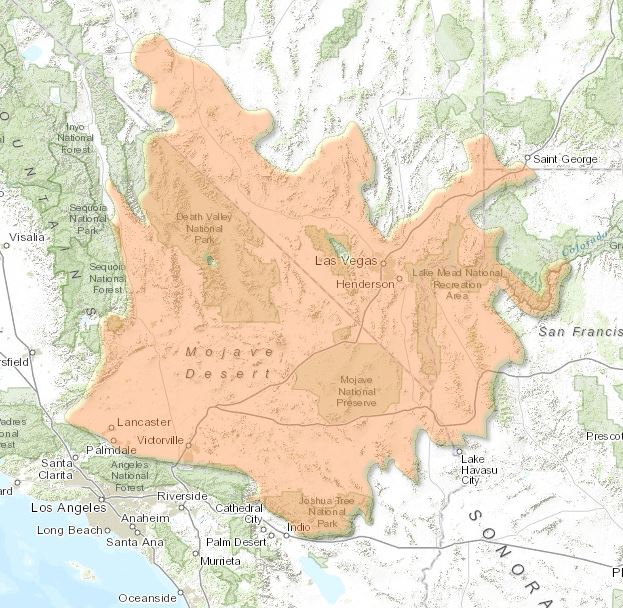Blogs posted from this ecoregion:
- Joshua Trees of the Mojave Desert (March 2019)
The ecoregion is centered in southern Nevada and adjacent California with small extensions into Utah and Arizona.
A few small patches of the Great Basin Montane Forests (NA0515) are embedded in the ecoregion (e.g., the Spring Mountains just west of Las Vegas, NV). Otherwise, adjacent ecoregions include the following: i) to the north, the Great Basin Shrub Steppe (NA1305); ii) to the east, the Colorado Plateau Shrublands (NA1304); iii) to the southeast, the Sonoran Desert (NA1310); iv) to the southwest, the California Montane Chaparral and Woodlands (NA1203); and v) to the west, blending into the Sequoia National Forest, the Sierra Nevada Forests (NA0527).
Description of the Ecoregion
The map above is a screen shot from WWF’s Wildfinder site, now no longer on-line.
Briefly, adapted from WWF’s description, the Mojave Desert is the smallest of the four American deserts. While the Mojave lies between the Great Basin Shrub Steppe and the Sonoran desert, its fauna is more closely allied with the lower Colorado division of the Sonoran desert. Dominant plants of the Mojave include creosotebush (Larrea tridentata), all-scale (Atriplex polycarpa), brittlebush (Encelia farinosa), desert holly (Atriplex hymenelytra), white burrobush (Hymenoclea salsola), and Joshua tree (Yucca brevifolia), the most prominent endemic species in the region.
The Mojave desert contains a range of elevations not found in other North American deserts. Elevation ranges from below sea level in Death Valley (-146 m) to over 1,600 m on some mountains. Most of the region lies between 610 and 1,220 m, giving rise to the term “high desert.” The Mojave receives little precipitation (between 65 and 190 mm annually) and dry lakes are a common feature of the landscape.
While the Mojave Desert is not as biologically distinct as the other desert ecoregions, distinctive endemic communities occur throughout it. For example, the Kelso Dunes in the Mojave National Preserve harbor seven species of endemic insects. The native range of California’s threatened desert tortoise (Gopherus agassizii) includes the Mojave and Colorado deserts. Other endemic fauna include the Mojave ground squirrel (Spermophilus mojavensis) and Amargosa vole (Microtus californicus scirpensis).
The Mojave desert is rich in ephemeral plants, most of which are endemic and are winter annuals. A majority of the fauna found in the Mojave desert also extends into the Sonoran or Great Basin deserts.
Birds of the Ecoregion
WWF highlights only LeConte’s thrasher (Toxostoma lecontei) as being characteristic of the ecoregion.
Resources for the Ecoregion Birder
There are probably many excellent references to the birds of the Mojave Desert but I have not searched them out.
80 spp. (March 24, 2019)
